
(Photo illustration by Idil Gozde.
Original photo by Ryan Loew/PublicSource)

(Photo illustration by Idil Gozde.
Original photo by Ryan Loew/PublicSource)
The iconic image of Pittsburgh features the three rivers rolling underneath its bridges with the Downtown buildings in relief.
But it is these large buildings and similar ones throughout the city that are the primary culprit of Pittsburgh's greenhouse gas problem. Buildings create 81 percent of emissions here, mostly from the use of electricity and natural gas, and the majority of those emissions come from commercial buildings, such as offices, hospitals, schools and churches.
If we looked at how Pittsburghers drove their cars or heated their homes, their energy footprint would look a lot like the citizens of Portland, Oregon, or Seattle, Washington. But the emissions from Pittsburgh’s commercial buildings are several times higher than their counterparts in those West Coast cities.
Unless Pittsburgh finds a way to buy more clean power from power plants, the only way to reduce the impact from buildings will be to improve the buildings themselves.
While the amount of emissions Pittsburgh’s buildings create looks bad, the city has emerged as a leader at figuring out how to change.
Since 2012, a group of about 500 buildings in Downtown and Oakland have committed to reducing their energy use 50 percent by 2030 — as part of the 2030 District initiative. In five years, those buildings have reduced their energy consumption by nearly 11 percent.
And the way they each started out was simple: by keeping track of their energy use.
This isn’t the case for many other buildings in the city. “You’d be surprised that some of the buildings I go to, that are pretty prominent buildings, don’t know how much energy they are using,” said Isaac Smith, the building performance analyst for the Green Building Alliance, the nonprofit that spearheads the city's 2030 District.

Isaac Smith, building performance analyst for the Green Building Alliance, said many building managers or owners don't know how much energy they're using. (Photo by Ryan Loew/PublicSource)
The city passed an ordinance in 2016 that, starting in June 2018, requires annual reporting of electricity, gas and water usage from all buildings with 50,000 square feet or more. The energy use details will be entered into a centralized system that city officials will be able to access and publish. When New York passed a similar law in 2009, the city's total emissions dropped 6 percent and have continued to decline.
Most of the buildings that the ordinance will affect are medium-sized, Smith said, between the size of the August Wilson Center and the Andy Warhol Museum. The new ordinance applies to about 475 buildings throughout the city, 75 of which were already tracking and reporting their energy use as participants of the 2030 District.
So one of the biggest indicators of whether the city’s climate action plan can succeed will be the response of these owners and building managers.
Right now, what’s happening in those buildings has been relatively unknown. “We’re about to venture into uncharted waters,” Smith said.
The problem is electric and gas usage. But it’s not as simple as looking at the energy bills, Smith said.
It doesn’t make sense to compare a hospital to an office tower. A hospital uses critical machines that are indispensable and energy intensive.
A suburban hospital will have a different profile than an intensive care unit Downtown that treats gunshot wounds, Smith said. And an office building with a gym and three restaurants will use more energy than one with only cubicles.
So it's important to not only look at which buildings are using the most energy overall, he said, but to also compare buildings to those that are similar.
Once the characteristics of each building have been fairly categorized, then building owners can start to look at how to reduce their energy use.
Phyllis Barber, the sustainability manager at Highmark, said when the company first started tracking energy use in 2009, their performance was middling.

Highmark made changes: It replaced fluorescent bulbs with LED ones and added sensors so they turned off when no one was in the room. Then they started replacing the air handling units in their HVAC system, floor by floor. In 2016, its office building on Fifth Avenue received its first Energy Star certification.
Tony Young, the vice president of facilities for Carnegie Museums of Pittsburgh, said the next step after figuring out how to collect the data is to get a full energy audit.
An audit allowed Young to see that if they spent $2.7 million on a new chiller plant, they would save enough money on energy for the plant to pay for itself after seven or eight years.
The idea is simple: When it’s cold outside, the Carnegie Museums’ building should be able to produce cold water without using energy to run a chiller. The new chiller was expensive at first but will save them hundreds of thousands of dollars per year, he said.
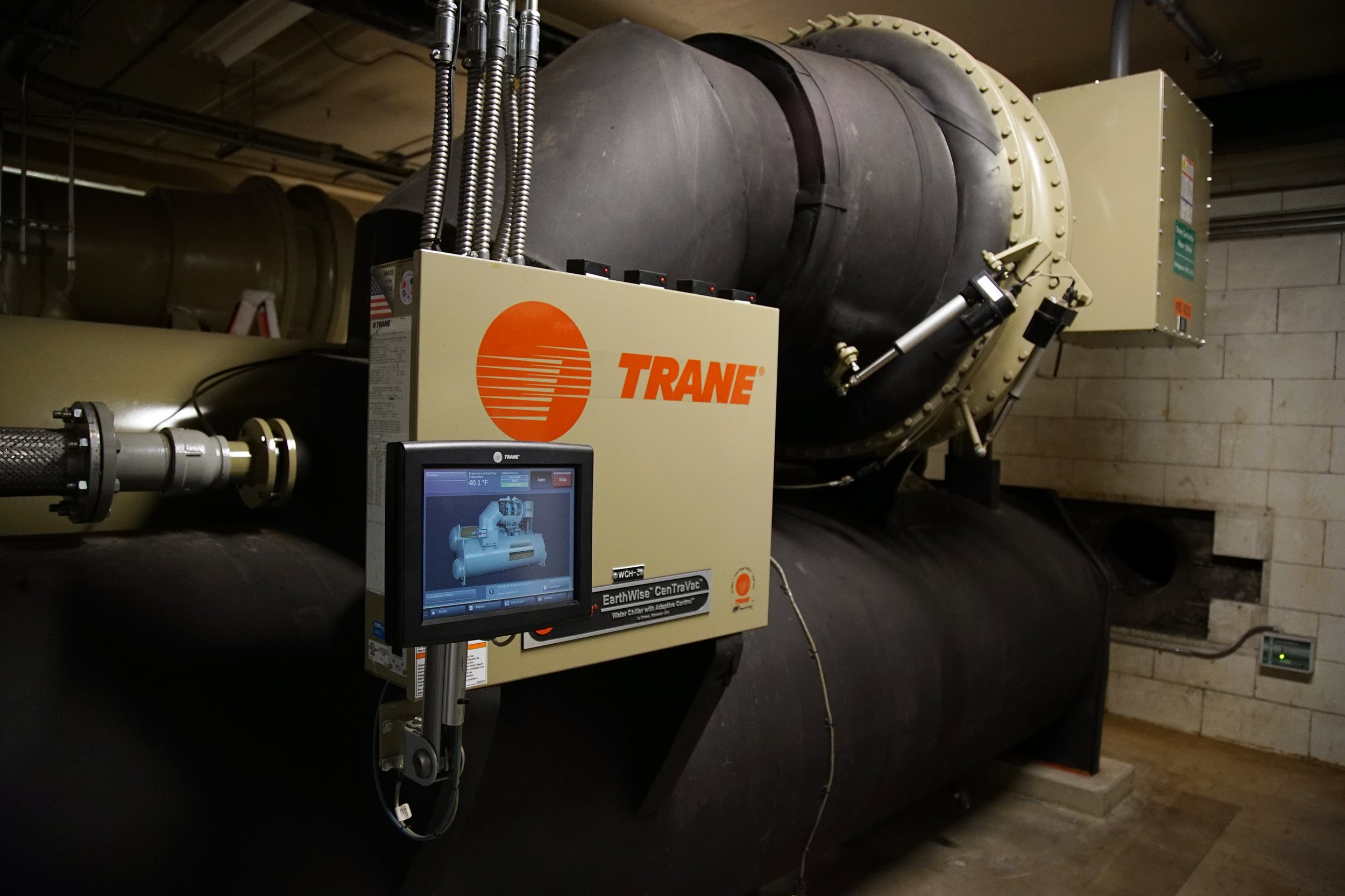
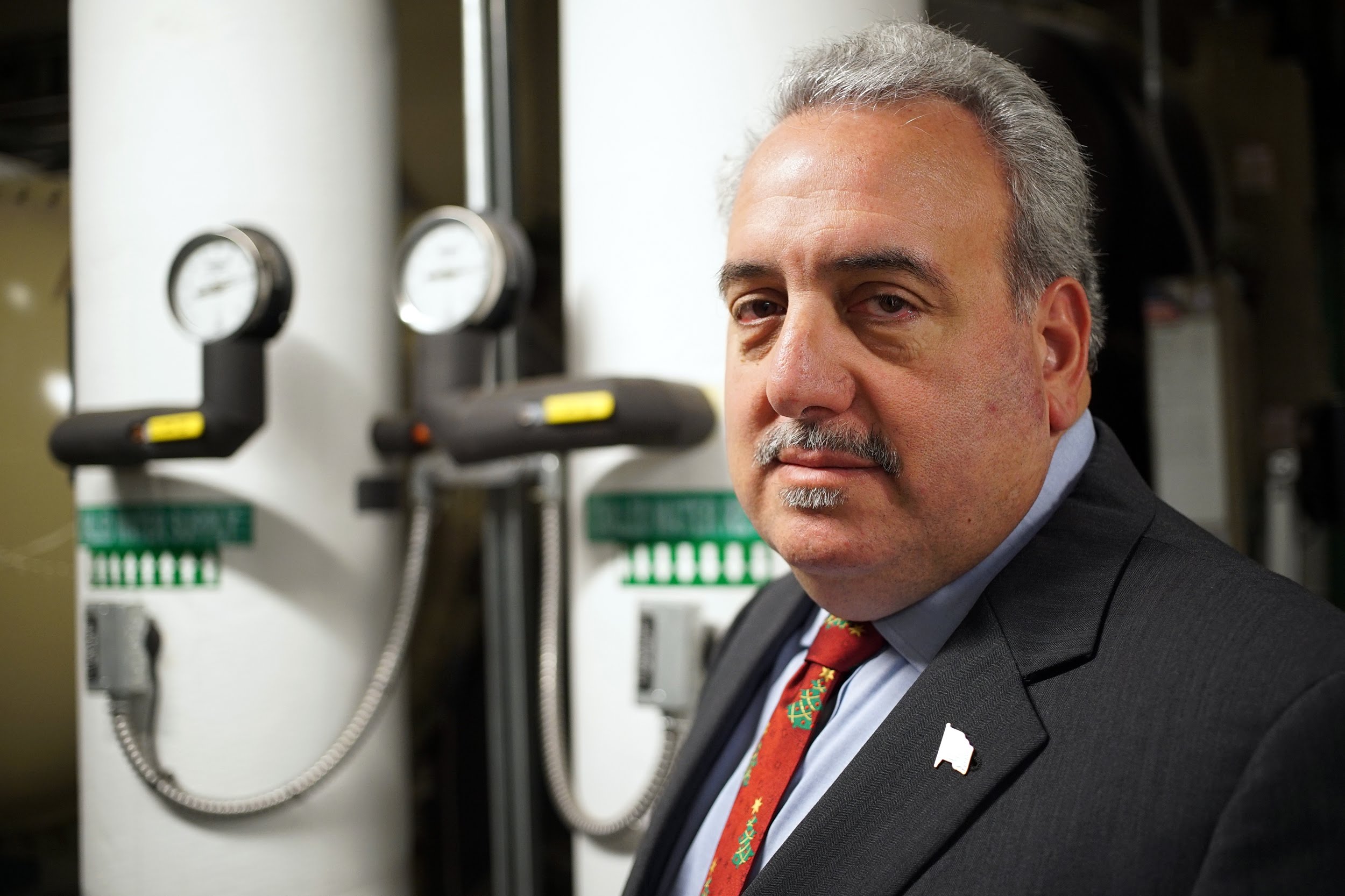
(Left) The Carnegie Museums installed a new swing chiller to reduce its energy costs. (Right) Tony Young, vice president for facilities, planning and operations at the Carnegie Museums of Pittsburgh. (Photos by Ryan Loew/PublicSource)
The reason he thinks that more building owners aren’t already doing this is they don’t have building managers who are trained in energy management and they haven’t hired outside consultants. And sometimes, he said, even if they did, they may not have enough money to pay for some of these investments.
The payoff has to be obvious. So Young expects to see more and more investments in water efficiency in the near future as the Pittsburgh Water and Sewer Authority raises its prices. The next wave of investments could be in more efficient toilets, urinals and faucets, he said.
But while these investments may make financial sense, they won’t do much to reduce the city’s commercial energy usage, the main cause of its greenhouse gas emissions.
Better data is one of the primary methods the city is focusing on to finally start reducing the city’s total emissions, said Grant Ervin, the city’s chief resilience officer.
The city calculated its greenhouse gas emissions twice over the last decade but didn’t see any overall drop. Emissions actually increased by more than a million tons of greenhouse gases.
“The one thing that continues to improve is the quality and availability of data,” Ervin said.
In the past, the city measured its total emissions every five years; Ervin says the city will measure emissions more frequently going forward but hasn't committed to exactly how often.

Grant Ervin, Pittsburgh's chief resilience officer, is leading the city's new plan to address climate change. (Photo by Justin Merriman/PublicSource)
The city's estimates keep getting more precise. Now, its data analysis takes into account how many hot and cold days there were. Energy use will go up when there are more days people need to turn on their heating or cooling. The city needs to know if what it’s doing is working or due to the luck of that year's weather.
Ervin said better data allowed the city to recognize it could get by on fewer city vehicles after evaluating the use of the current fleet. And, by collecting more precise data in the City-County building on Grant Street, he said the city realized the heating and cooling had sometimes been running at the same time.
But while more information about emissions will help track its overall progress, it’s going to be up to individuals and organizations to stop using so much electricity and gas.
And that means the people in charge of its buildings need to get better data, too.
Mohammed Kahn, a dentist in Canonsburg, needs the operating room in his office to be a cool 65 degrees. But Kahn and his staff didn’t want their patients to be shivering in the waiting room.
They scattered space heaters in the rooms they wanted to be warmer, a drain on energy and money.
So Kahn sought a solution from Bob Fields, the chief revenue officer at HiberSense, a local startup.
HiberSense installed sensors in all of the rooms, each of which is tied to motorized vents. The vents open and close only when that room needs it, rather than their previous system that pumped air into every room. It also detects motion and adjusts when people enter or leave.
The staff can now keep rooms at slightly different temperatures without having to stand on a chair and adjust the ceiling vents by hand.
It cost a couple of thousand dollars to entirely replace the system, and the office’s energy use has fallen by 30 percent, Fields said.
The vast majority of people who want to make a change do so because they want to be more comfortable, Fields said. One side of their office is too cold, and another is too hot. For most people, he said, it’s a side benefit that they may save money or help the environment.
But in the long term, Phipps Conservatory Executive Director Richard Piacentini said companies need to bring the natural environment into their work spaces.
Piacentini has been trying to use Phipps as a model for what buildings in the city could be like. The main office, the Center for Sustainable Landscapes, produces more energy than it uses.
It has solar panels, a green roof and geothermal heating. On a recent day in December, there wasn’t a single overhead light on in their office space because the abundance of windows brought in so much natural light.
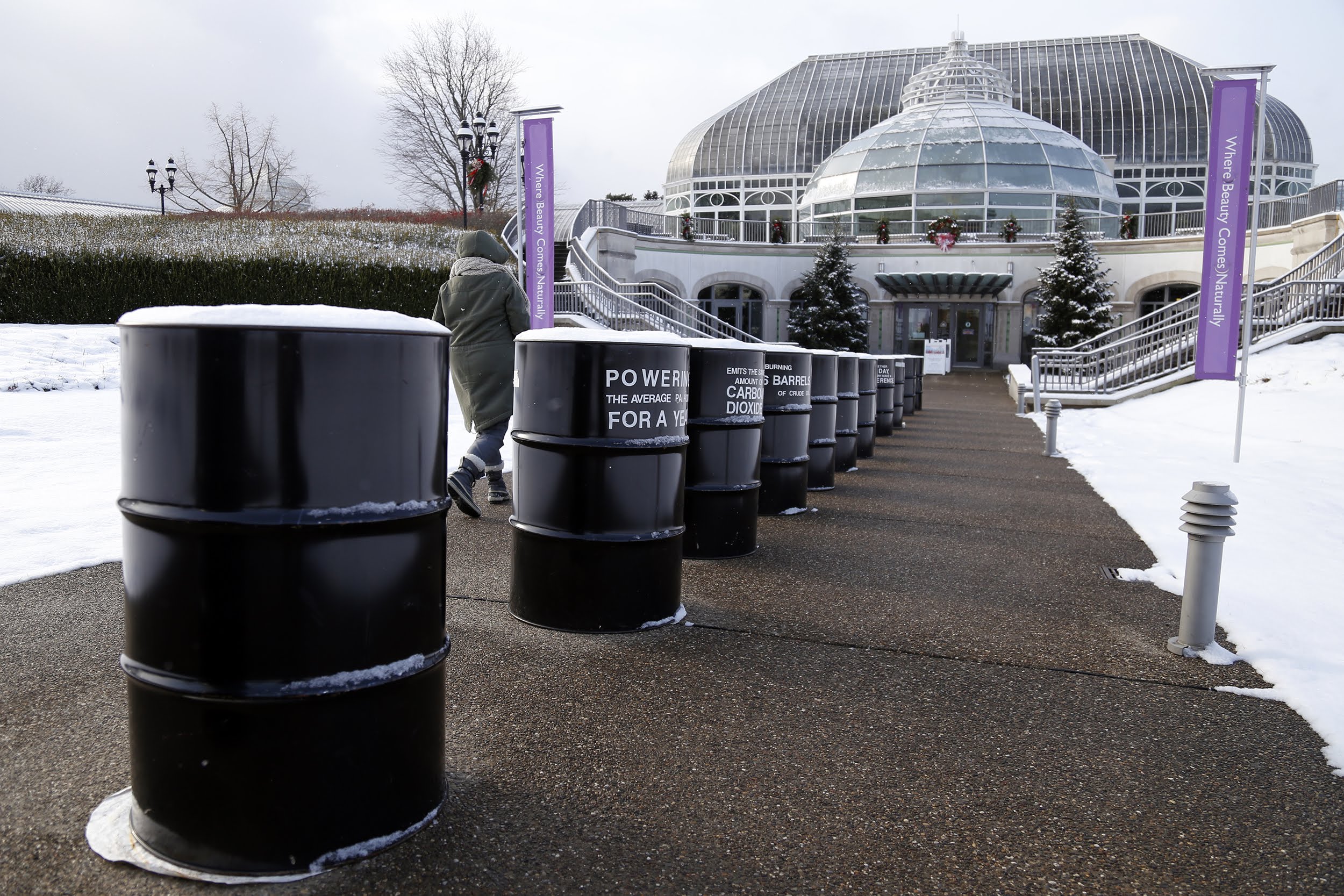
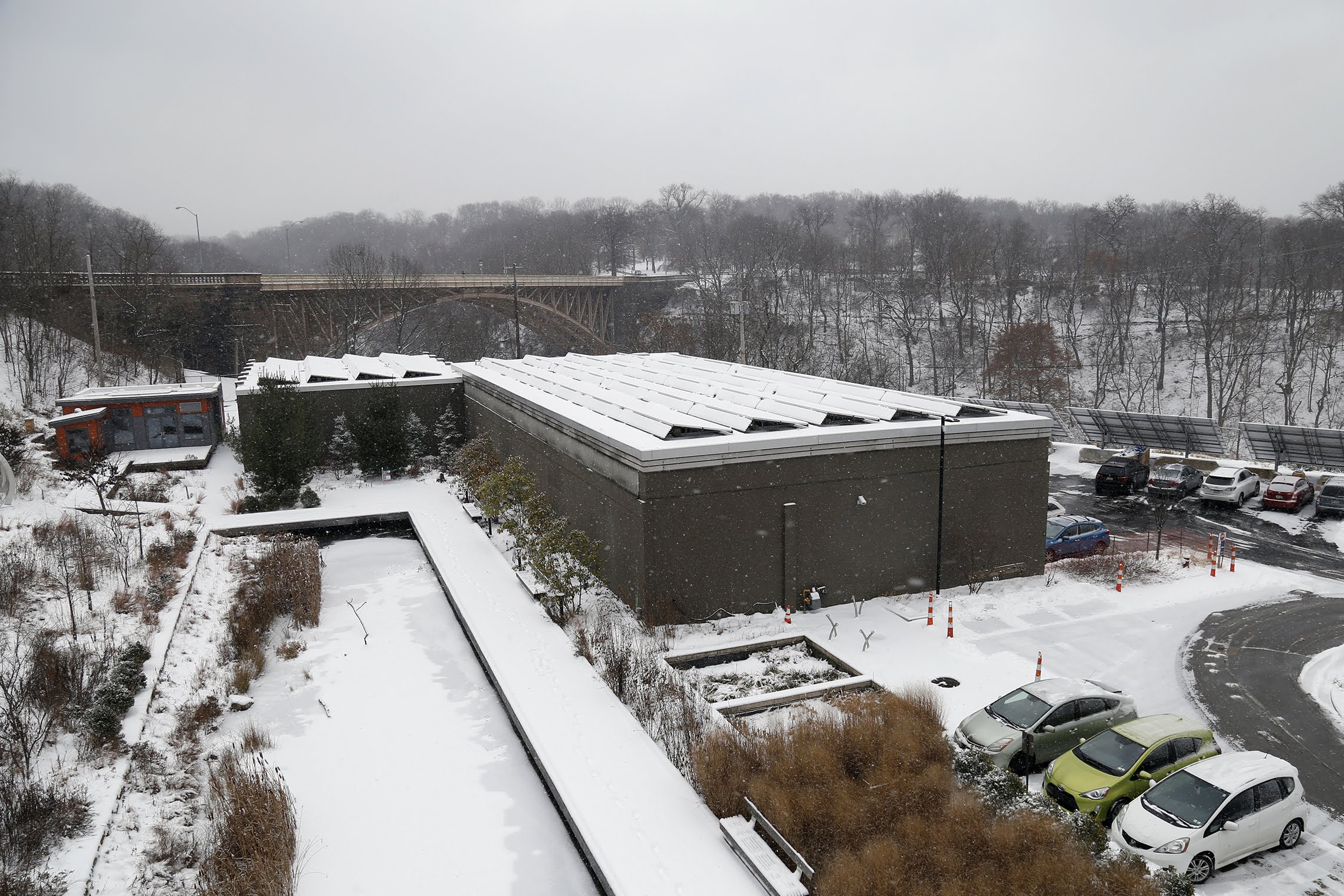
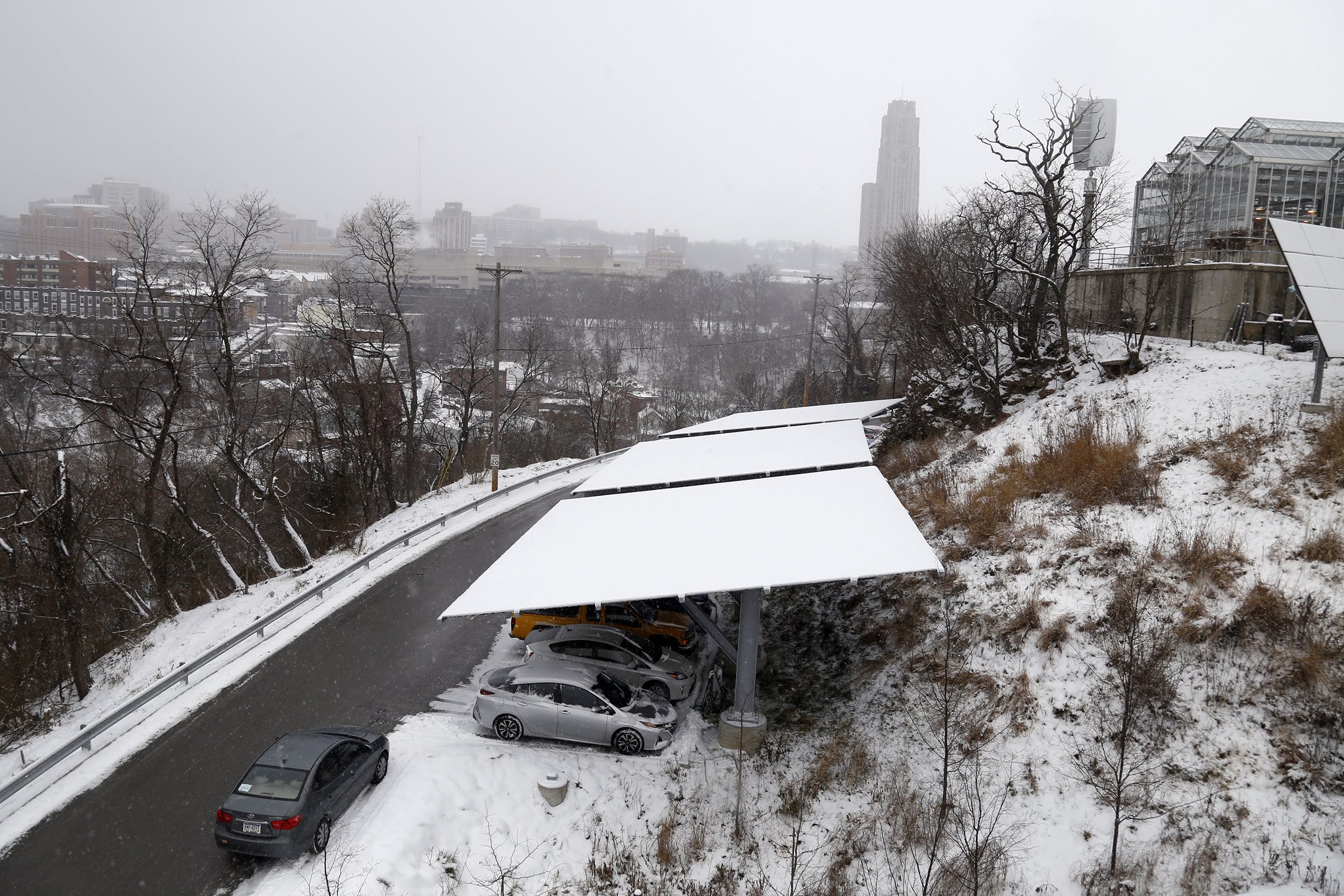

The Phipps Conservatory and Botanical Gardens. (Top left) A public display with oil barrels representing an average home's emissions. Phipps uses solar panels to power an electric vehicle charging station and plans to use solar to power the old public works building when it undergoes renovations. (Photos by Ryan Loew/PublicSource)
But Phipps’ most influential project, in terms of the city’s current climate plan, could be the old cinder-block public works building out back. The vast majority of Pittsburgh's buildings were built before 1960 and will likely have to be renovated rather than torn down.
The plan is to power the building through solar panels and the batteries they feed into.
The cinder-block walls on the old building may actually be more efficient than windows, said Jason Wirick, Phipp’s director of facilities and sustainability management. But the plan is to replace the cinder blocks with floor-to-ceiling windows in the workshop space because it could satisfy two priorities: maintain carbon neutrality and provide workers with sunlight.
Ashley Dean, a human resources coordinator at Phipps, said when she gets stressed out at work, she’ll often look out the windows. The trees and sun calm her.
This stress reduction is the sort of of long-term health benefit that many businesses aren’t thinking about, Piacentini said.
Every tour they give, every sign they write, every building they construct, they see it as an opportunity to lessen the feeling of separation between buildings and the environment.
Just trying to achieve short-term efficiencies, whether it be a reduction in carbon emissions or profits, doesn’t address the underlying disconnect, Wirick said.
“That’s what has gotten us into this problem in the first place,” he said.
Story by Oliver Morrison
Fact-checked by Matt Petras
Edited by Halle Stockton and Mila Sanina
Illustrations by Idil Gözde
Design and development by Natasha Khan
Have additional questions or thoughts about this story? Email Oliver at oliver@publicsource.org or find him on Twitter @ORMorrison.
Who in the Pittsburgh region is making a unique or admirable effort to reduce their carbon footprint? How does the concern over climate change shape their everyday behavior? PublicSource is looking for nominations for Pittsburgh’s Climate BFF.
We will interview the greenest and most interesting nominees and feature short profiles. Email reporter Oliver Morrison at oliver@publicsource.org or call him at 412-515-0063 to share who you are nominating (it can be you!) and why the person deserves to be Pittsburgh’s Climate BFF.